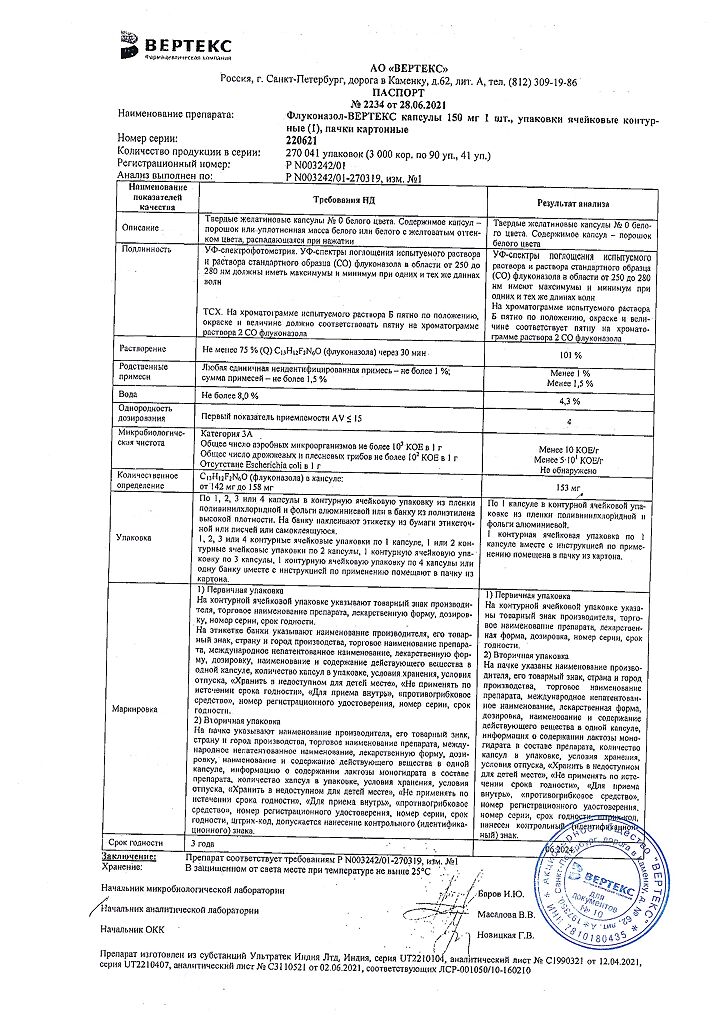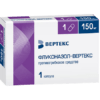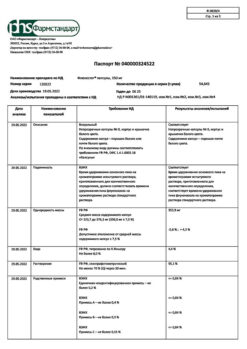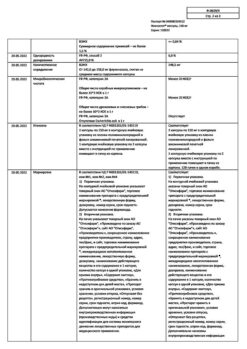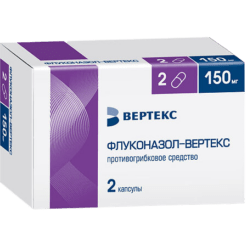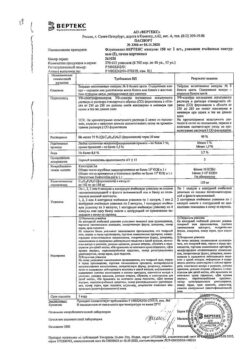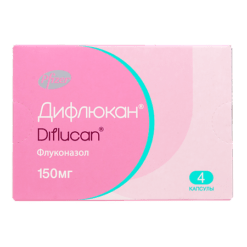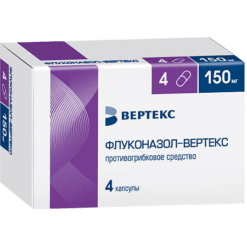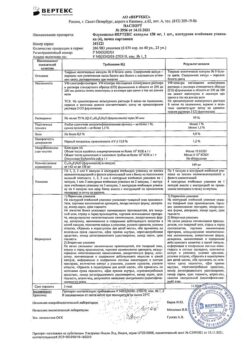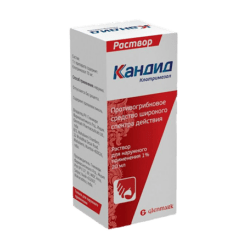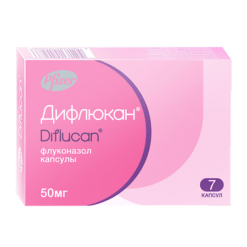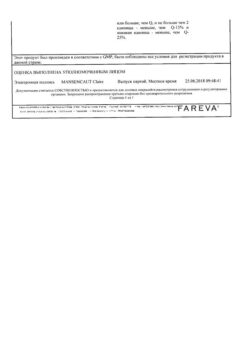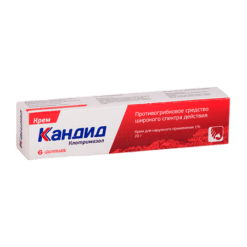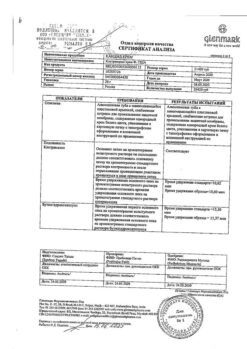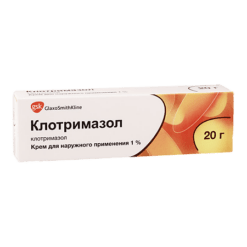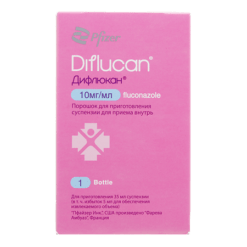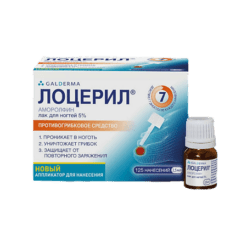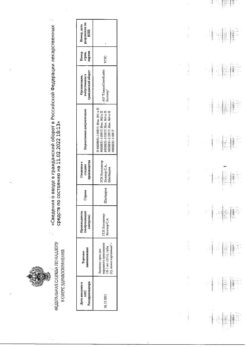No products in the cart.
Fluconazole-Vertex, 150 mg capsules
€1.70 €1.42
Description
Pharmacotherapeutic group: antifungal agent.
CodeATH: J02AC01
Pharmacological properties
Pharmacodynamics
Fluconazole is a representative of the class of triazole antifungal agents and is a potent selective inhibitor of the fungal enzyme 14-α-demethylase. The drug prevents conversion of lanosterol into ergosterol – the main component of cell membranes of fungi.
The drug is effective against opportunistic mycoses, including those caused by Candida spp. (Candida albicans, Candida tropicalis), Cryptococcus neoformans, Microsporum spp. Fluconazole activity has also been shown in models of endemic mycoses, including infections caused by Blastomyces dermatidis, Coccidioides immitis and Histoplasma capsulatum. However, blastomycetes, histoplasmids, paracoccidioides and sporotrix are less sensitive to fluconazole than to other azoles.
Pharmacokinetics
Fluconazole is well absorbed after oral administration, its bioavailability is 90%. Maximum concentration (Cmax) after oral administration, on an empty stomach of 150 mg is 90% of the plasma content when administered intravenously at a dose of 2.5-3.5 mg/kg.
Concomitant ingestion does not affect absorption of the drug taken orally. Plasma concentrations reach a peak in 0.5-1.5 h (TSmax) after administration. Plasma concentrations are directly proportional to the dose. The 90% level of equilibrium concentration is reached by 4-5 days of treatment with the drug (when taken once daily).
The first day’s dosing of twice the usual daily dose allows the drug to reach a level in plasma equal to 90% of the equilibrium concentration by the second day. The apparent volume of distribution is close to the total volume of water in the body. Binding to plasma proteins is low – 11-12%.
Fluconazole penetrates well into all body fluids, including cerebrospinal fluid. The drug concentrations in saliva and sputum are similar to its content in plasma. In patients with fungal meningitis the content of fluconazole in cerebrospinal fluid reaches 80% of its level in plasma.
In the stratum corneum, epidermis, dermis and sweat fluid high concentrations are achieved that exceed serum levels.
Less than 5% of fluconazole is metabolized during first passage through the liver. The half-life (T1/2) of fluconazole is about 30 hours. The long T1/2 allows a single dose to be used for the treatment of vaginal candidiasis and allows once-daily administration for other indications. Fluconazole is mainly excreted by the kidneys; about 80% of the administered dose is excreted unchanged by the kidneys. Fluconazole clearance is proportional to creatinine clearance. No fluconazole metabolites were detected in peripheral blood.
Indications
Indications
Cryptococcosis, including cryptococcal meningitis and other localizations of this infection (including lungs, skin), both in patients with a normal immune response and in patients with various forms of immunosuppression (including AIDS patients, organ transplants); the drug can be used to prevent cryptococcal infection in patients with AIDS;
generalized candidiasis, including candidemia, disseminated candidiasis and other forms of invasive candidal infections (infections of the peritoneum, endocardium, eyes, respiratory and urinary tract). Treatment can be carried out in patients with malignant neoplasms, patients in the intensive care unit, patients undergoing cytostatic or immunosuppressive therapy, as well as in the presence of other factors predisposing to the development of candidiasis;
candidiasis of the mucous membranes, incl. oral cavity and pharynx (including atrophic candidiasis of the oral cavity associated with wearing dentures), esophagus, non-invasive bronchopulmonary candidiasis, candiduria, cutaneous candidiasis; prevention of relapse of oropharyngeal candidiasis in patients with AIDS;
genital candidiasis: vaginal candidiasis (acute and chronic recurrent), prophylactic use to reduce the frequency of relapses of vaginal candidiasis (3 or more episodes per year); candidal balanitis;
prevention of fungal infections in patients with malignant neoplasms who are predisposed to such infections as a result of chemotherapy with cytostatics or radiation therapy;
mycoses of the skin, including mycoses of the feet, body, and groin area; pityriasis versicolor (varicolored) lichen, onychomycosis; skin candidiasis;
deep endemic mycoses, including coccidioidomycosis, paracoccidioidomycosis, sporotrichosis and histoplasmosis in patients with normal immunity.
Pharmacological effect
Pharmacological effect
Pharmacotherapeutic group: antifungal agent.
CodeATX: J02AC01
Pharmacological properties
Pharmacodynamics
Fluconazole, a representative of the class of triazole antifungals, is a powerful selective inhibitor of the fungal enzyme 14-α-demethylase. The drug prevents the transition of lanosterol to ergosterol, the main component of fungal cell membranes.
The drug is effective against opportunistic mycoses, including those caused by Candida spp. (Candida albicans, Candida tropicalis), Cryptococcus neoformans, Microsporum spp., Trichophyton spp. Fluconazole has also been shown to be active in models of endemic mycoses, including infections caused by Blastomyces dermatidis, Coccidioides immitis and Histoplasma capsulatum. However, blastomycetes, histoplasmas, paracoccidioides and sporothrix are less sensitive to fluconazole than to other azoles.
Pharmacokinetics
After oral administration, fluconazole is well absorbed, its bioavailability is 90%. The maximum concentration (Cmax) after oral administration, on an empty stomach, 150 mg is 90% of the plasma content when administered intravenously at a dose of 2.5-3.5 mg/kg.
Concomitant food intake does not affect the absorption of the drug taken orally. Plasma concentrations reach a peak 0.5-1.5 hours (TCmax) after administration. Plasma concentrations are directly proportional to dose. 90% level of equilibrium concentration is achieved by 4-5 days of treatment with the drug (when taken once a day).
Use on the first day of a dose 2 times higher than the usual daily dose allows you to achieve a plasma level of the drug equal to 90% of the equilibrium concentration by the second day. The apparent volume of distribution approaches the total volume of water in the body. Plasma protein binding is low – 11-12%.
Fluconazole penetrates well into all biological fluids of the body, including cerebrospinal fluid. Concentrations of the drug in saliva and sputum are similar to its content in plasma. In patients with fungal meningitis, the fluconazole content in the cerebrospinal fluid reaches 80% of its plasma level.
In the stratum corneum, epidermis, dermis and sweat fluid, high concentrations are reached that exceed serum concentrations.
Less than 5% of fluconazole is metabolized on the first pass through the liver. The half-life (T1/2) of fluconazole is about 30 hours. The long T1/2 allows the use of a single dose of the drug for the treatment of vaginal candidiasis and ensures that the drug is taken once a day for other indications. Fluconazole is excreted primarily by the kidneys; approximately 80% of the administered dose is excreted unchanged by the kidneys. Fluconazole clearance is proportional to creatinine clearance. No fluconazole metabolites were detected in peripheral blood.
Special instructions
Special instructions
Treatment must be continued until clinical and hematological remission occurs. Premature cessation of treatment leads to relapses.
During treatment, it is necessary to monitor blood counts, kidney and liver function. If renal and liver dysfunction occurs, you should stop taking the drug.
In rare cases, the use of fluconazole was accompanied by toxic changes in the liver, incl. with a fatal outcome, mainly in patients with serious concomitant diseases. In the case of hepatotoxic effects associated with fluconazole, there was no obvious dependence on the total daily dose, duration of therapy, gender and age of the patient.
The hepatotoxic effects of fluconazole were usually reversible; its signs disappeared after cessation of therapy. If clinical signs of liver damage that may be associated with fluconazole appear, the drug should be discontinued.
People with AIDS are more likely to develop severe skin reactions when taking many drugs. In cases where a rash develops in patients with a superficial fungal infection and is assessed as definitely related to fluconazole, the drug should be discontinued. If a rash appears in patients with invasive/systemic fungal infections, they should be carefully monitored and fluconazole should be discontinued if bullous changes or erythema multiforme occur.
Caution must be exercised when taking fluconazole concomitantly with cisapride, rifabutin or other drugs metabolized by the cytochrome P 450 system.
Active ingredient
Active ingredient
Fluconazole
Composition
Composition
1 capsule contains:
Active substance:
fluconazole 50 mg or 150 mg.
Excipients:
corn starch, povidone (polyvinylpyrrolidone),
colloidal silicon dioxide (aerosil),
sodium lauryl sulfate,
calcium stearate,
lactose.
Hard gelatin capsules:
for a dosage of 50 mg – gelatin,
titanium dioxide,
azorubine dye,
sunset yellow dye and for a dosage of 150 mg – gelatin,
titanium dioxide
Pregnancy
Pregnancy
The use of the drug in pregnant women is not advisable, with the exception of severe or life-threatening forms of fungal infections, if the expected effect exceeds the possible risk to the fetus.
Fluconazole is found in breast milk in the same concentration as in plasma, so its use during lactation is not recommended.
Contraindications
Contraindications
Hypersensitivity to fluconazole, other components of the drug or other azole compounds; simultaneous use of terfenadine (while constantly taking fluconazole at a dose of 400 mg per day or more), cisapride or astemizole and other drugs that prolong the QT interval and increase the risk of developing severe arrhythmias; lactose intolerance; lactase deficiency; glucose-galactose malabsorption; lactation period; children under 3 years of age (for this dosage form).
With caution: liver and/or renal failure, the appearance of a rash due to the use of fluconazole in patients with superficial fungal infection and invasive/systemic fungal infections, simultaneous use of terfenadine and fluconazole at a dose of less than 400 mg per day, potentially proarrhythmogenic conditions in patients with multiple risk factors (organic heart disease, disorders electrolyte balance, simultaneous use of medications that cause arrhythmias); patients with acetylsalicylic acid intolerance, pregnancy.
Side Effects
Side Effects
From the digestive system: decreased appetite, changes in taste, abdominal pain, vomiting, nausea, diarrhea, flatulence, rarely – impaired liver function (jaundice, hepatitis, hepatonecrosis, hyperbilirubinemia, increased activity of alanine aminotransferase, aspartate aminotransferase, increased activity of alkaline phosphatase, hepatocellular necrosis), incl. heavy.
From the nervous system: headache, dizziness, excessive fatigue, rarely – convulsions.
From the hematopoietic organs: rarely – leukopenia, thrombocytopenia (bleeding, petechiae), neutropenia, agranulocytosis.
Allergic reactions: skin rash, rarely – exudative erythema multiforme (including Stevens-Johnson syndrome), toxic epidermal necrolysis (Lyell’s syndrome), anaphylactoid reactions (including angioedema, facial edema, urticaria, skin itching).
From the cardiovascular system: increased duration of the QT interval, ventricular fibrillation/flutter.
Other: rarely – renal dysfunction, alopecia, hypercholesterolemia, hypertriglyceridemia, hypokalemia.
Overdose
Overdose
Symptoms: nausea, vomiting, diarrhea; in severe cases, convulsions, hallucinations, and paranoid behavior may occur.
Treatment: symptomatic, gastric lavage; Since fluconazole is excreted by the kidneys, forced diuresis is recommended. Hemodialysis for 3 hours reduces the plasma concentration by 2 times.
Interaction with other drugs
A single dose of fluconazole for the treatment of vaginal candidiasis is not accompanied by significant interactions. However, when using several or higher doses of the drug simultaneously with other drugs, the following drug interactions are possible:
The interaction of fluconazole with terfenadine, cisapride and astemizole can lead to an increase in the plasma concentrations of these drugs, which in turn can cause a prolongation of the QT interval and lead to serious cardiac arrhythmias. Fluconazole inhibits enzymes of the P450 system in the liver, thereby reducing the metabolism of terfenadine, cisapride and astemizole. The simultaneous administration of fluconazole and these drugs is contraindicated.
When warfarin and fluconazole are prescribed together, an increase in prothrombin time is observed. In this regard, it is necessary to monitor prothrombin time in patients simultaneously receiving fluconazole and coumarin anticoagulants.
Fluconazole prolongs T1/2 of oral hypoglycemic drugs (sulfonylurea derivatives). In patients with diabetes mellitus, fluconazole and sulfonylurea derivatives can be co-administered, but the possible risk of hypoglycemia must be taken into account.
It must be taken into account that with repeated simultaneous administration of hydrochlorothiazide and fluconazole, the concentration of fluconazole in plasma increases.
Rifampicin accelerates the metabolism of fluconazole. It is necessary to increase the dose of fluconazole accordingly when using them simultaneously.
In patients who have undergone renal transplantation, fluconazole may increase plasma concentrations of cyclosporine. In this regard, it is recommended to monitor the concentration of cyclosporine in patients simultaneously receiving cyclosporine and fluconazole.
Fluconazole increases plasma theophylline concentrations. In this regard, it is recommended to monitor theophylline concentrations in patients simultaneously receiving theophylline and fluconazole.
Fluconazole may increase plasma concentrations of indinavir and midazolam. When these drugs are co-administered with fluconazole, their dose should be reduced accordingly.
Clinical studies have shown that, as a result of slowing down the metabolism of zidovudine, its plasma concentration may increase when administered concomitantly with fluconazole. Monitoring of patients receiving both of these drugs simultaneously is necessary, as in this case the incidence of side effects of zidovudine may increase.
Enhances the pharmacological effects of rifabutin (with simultaneous use, cases of uveitis have been described) and phenytoin to a clinically significant extent (with combined use, monitoring the concentration of phenytoin in plasma is necessary). Fluconazole increases serum concentrations of phenytoin. When administered concomitantly, it is necessary to monitor the dose of phenytoin and adjust it accordingly.
Increases tacrolimus concentrations – risk of nephrotoxicity.
Doctors should note that interactions with other drugs have not been specifically studied, but are possible.
Storage conditions
Storage conditions
In a dry place, protected from light, at a temperature of 15–25 °C.
Shelf life
Shelf life
2 years
Manufacturer
Manufacturer
Vertex, Russia
Additional information
| Shelf life | 2 years |
|---|---|
| Conditions of storage | In a dry, light-protected place at 15-25 °C. |
| Manufacturer | Vertex, Russia |
| Medication form | capsules |
| Brand | Vertex |
Other forms…
Related products
Buy Fluconazole-Vertex, 150 mg capsules with delivery to USA, UK, Europe and over 120 other countries.


